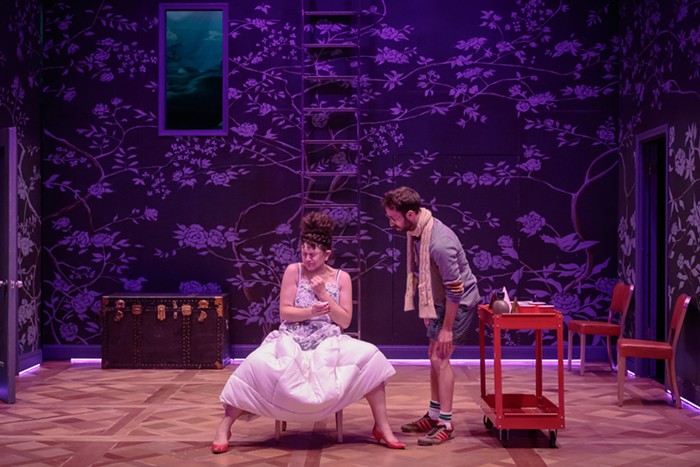With standout inclusions in both this year's Oregon Biennial and the grey/area exhibition at Guestroom Gallery, Ty Ennis has steadily built a reputation as one of the city's most promising young artists. The Bronze Loss, Ennis' third solo exhibition at the New American Art Union in as many years, continues to show how rapidly his work is maturing. This new batch of drawings largely departs from an illustrative style; there's far more rigorous detail in these works, most of which are smaller than a sheet of notebook paper. Ennis has also expanded his use of expressive washes of ink to augment the emotional range of some pieces; the ink's fuzzy bleeds diffuse all the precision of his slender lines. But, as with his solo show from last year, the notion of "maturity" seems a little ironic when discussing his work.
His desolate imagery often projects a degree of maudlin narcissism, in which a spilled can of Hamm's or a lone rose approximate a pat, uncomplicated version of loneliness and longing. Sometimes, Ennis' meaning is nakedly direct. In "A Plea Forever to Never Die," the artist scrawls the word "please" dozens of times in a dense block before dangling a single sentence beneath: "Let us live just like this forever and never die." Perhaps it's meant to plant a seed of narrative in the show or simply set a tone of abject desperation, but such a lack of subtlety actually undermines the work, leading viewers to interpret the images a particular way. The title also conjures a similarly insistent plea in a song by the Smiths, in which the perennial moper Morrissey croons, "Please, please, please let me get what I want this time." Such references are hardly beyond Ennis, who often relies heavily on a viewer's associations to reinforce the impact of his own work. From a modified cover of J.D. Salinger's Nine Stories to a dedication to Leonard Cohen, it's a kind of shortcut to communicating depth that isn't terribly unlike how a teenager constructs a sense of self by the band T-shirts he wears.
In Ennis' last solo exhibition, one drawing acknowledged a debt to Marcel Dzama and Chris Johanson. In The Bronze Loss, Ennis has distanced himself from those artists' faux naïf drawing styles, turning his attention to Picasso. Most obviously, there is "Hooray Picasso," a portrait of the iconic artist. But Picasso's influence is also present in "Drunks." In this piece, a weeping man slumps over with his face buried in his hands while two disembodied heads float above him like apparitions. The posture of the figure bears an unmistakable resemblance to the elongated, slouching drunks and beggars of Picasso's Blue Period. "Drunks" may lack the same tautly controlled color palette of the paintings it references, but it preserves their misery.
For all the qualified criticism, Ennis' best work grips a viewer's imagination by implicating them in the process of "finishing" the drawing. "And Cast Within a Well Hidden Well Within My Mind," for example, depicts a well surrounded by leafless winter trees. In typical fashion, Ennis utilizes liberal white space, so that the scene is mysteriously ungrounded. The deliberate, thin lines of the well shrouded by trees seem to actually spring out of nothingness. It's as if Ennis is withholding visual details to tantalize the viewer with unanswered questions: Where is this place? What happens there?
"Houseful of Emptiness" is another haunting image. Calling to mind a black-and-white architectural drawing, Ennis meticulously represents every detail of a two-story house, from its shingles to the folds of the curtains that hang in each window. The image draws the viewer in, though, as knotted bed sheets stream from the upstairs and attic windows to the ground in brilliant yellows and pinks. Given Ennis' vaguely storybook style, an implied narrative lurks in each drawing. So even if the brightly colored bed sheets are meant to symbolize an abstract notion of freedom or escapism, the drawing's execution promises concrete characters and conflict. But like "And Cast Within a Well," "Houseful of Emptiness" inspires more questions than it answers—which is exactly what makes these images so hard to shake.
For now, Ennis seems content to remain willfully adolescent with works that are either painfully naked or guardedly aloof, but seldom anywhere in between. Still, The Bronze Loss shows the artist moving in potentially exciting directions, from formal experimentation to mining the work of the masters for inspiration, in lieu of contemporaries like Dzama and Johanson. Most importantly, Ennis has moved one step closer to matching his masterful stylistic sensibility with genuine pathos. JOHN MOTLEY












